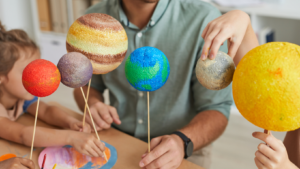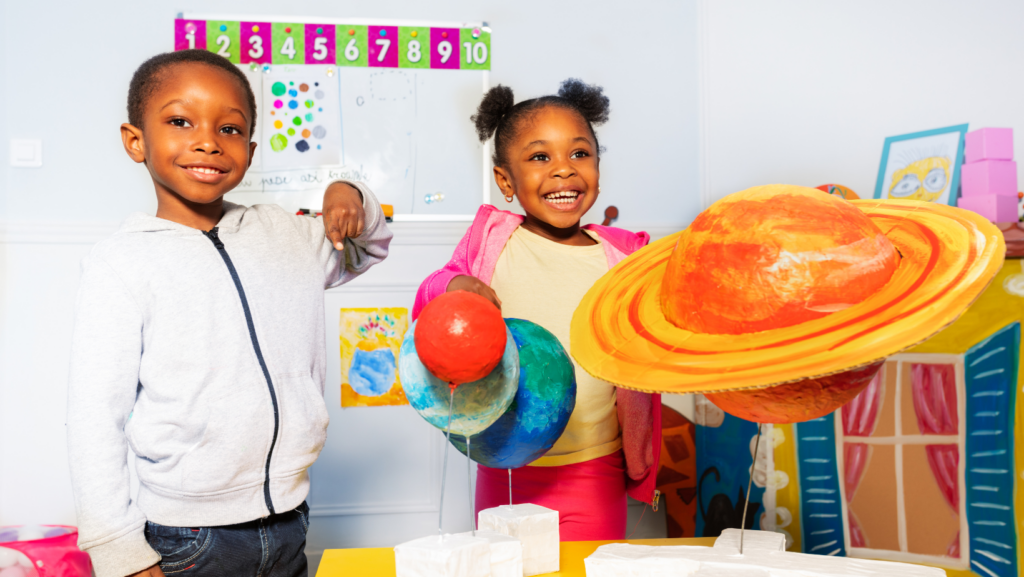Get ready for an exciting journey across the cosmos as we delve into some fascinating facts about Mercury, the smallest planet in our solar system. Mercury, named after the swift-footed Roman messenger god, holds many surprises that’ll leave kids wide-eyed with wonder.
Fun Facts About Mercury For Kids

Time to dive into some astonishing and fun facts about Mercury for kids, size and the great distances it spans in its fascinating journey around the Sun!
Mercury, though the smallest planet in our solar system, has impressive dimensions. Standing at an estimated diameter of 3,032 miles, Mercury is incomparable to Earth’s 7,918 miles. However, this visual might put things into perspective: roughly 18 Mercuries could fit inside Earth. Despite its size, Mercury boasts a massive iron core, occupying about 42% of the planet’s total volume.
A Day on Mercury
Mercury’s fascinating characteristics extend to its unique periods of day and night, as well our its year. This section aims to provide intriguing details about Mercury’s day, year, and temperature shifts.
Mercury, with its slow rotation and swift orbit, has an unusual pattern of days and years. A day on Mercury takes 58.6 Earth days to rotate once on its axis, which to put simply is the length of Mercury’s day. On the other hand, Mercury orbits the Sun so fast, that its year is just 87.97 Earth days, making it the shortest year in the solar system. Consequentially, one Mercury day lasts two-thirds of a Mercury year.
Temperature Extremes on Mercury
Mercury is a planet of extremes, especially when it comes to temperature. The lack of atmosphere to regulate temperature leads to dramatic fluctuations between day and night. During the day, temperatures can rise as high as 800 degrees Fahrenheit (430 degrees Celsius). Come nightfall, without the Sun’s warmth, the temperature plummets to a chilling -290 degrees Fahrenheit (-180 degrees Celsius). Thus, Mercury is simultaneously scorched and frozen, an apparent contradiction on this fascinating planet.
The Surface and Atmosphere of Mercury

Taking a look at Mercury’s surface reveals an interesting geological past. Let’s delve into Mercury’s topographic features and find out if an atmosphere exists on this planet.
Mercury’s outer shell, encapsulating an array of scars from cosmic collisions, presents a striking appearance. Major craters, resulting from numerous meteorite impacts, litter its surface. Clavius, Debussy, and Tolkien are some of the large craters, presenting a testament to Mercury’s turbulent past. Mercury also boasts a great range of mountains, with Caloris Montes being an exemplar.
Does Mercury Have an Atmosphere?
Contrary to common assumptions, Mercury does possess an atmosphere, albeit rather thin compared to Earth’s. Labelled as an ‘exosphere’, it comprises atoms blasted off the planet’s surface by solar wind. Primarily composed of oxygen, sodium, hydrogen, helium, and potassium, Mercury’s exosphere is so thin that atoms rarely collide with each other. Solar winds and intense sunlight continually erode this exosphere, leading to its continual microscopic renewal.
Fun Experiments and Activities

Let’s dive into exciting and educational activities to better understand Mercury. This section presents various experiments replicating unique features and aspects of Mercury.
An experiment simulating Mercury’s craters offers children a practical and fun way to appreciate Mercury’s pock-marked surface. Start with a large basin and fill it up with flour and cocoa powder — the flour representing the planet’s surface and the cocoa powder, the uppermost layer of rubble. For the meteor’s representation, use small objects like marbles or little balls.
A fun and engaging activity is creating a scale model of the solar system to understand Mercury’s orbit better. The model could include a scaled representation of the distance between the Sun and the remaining planets, showcasing Mercury’s position as the nearest planet to the Sun. Anchor points or markers can represent planets, while strings stretched across a space depict their respective orbits.

